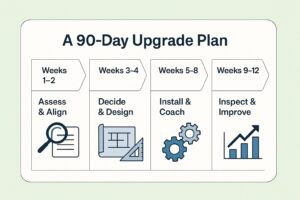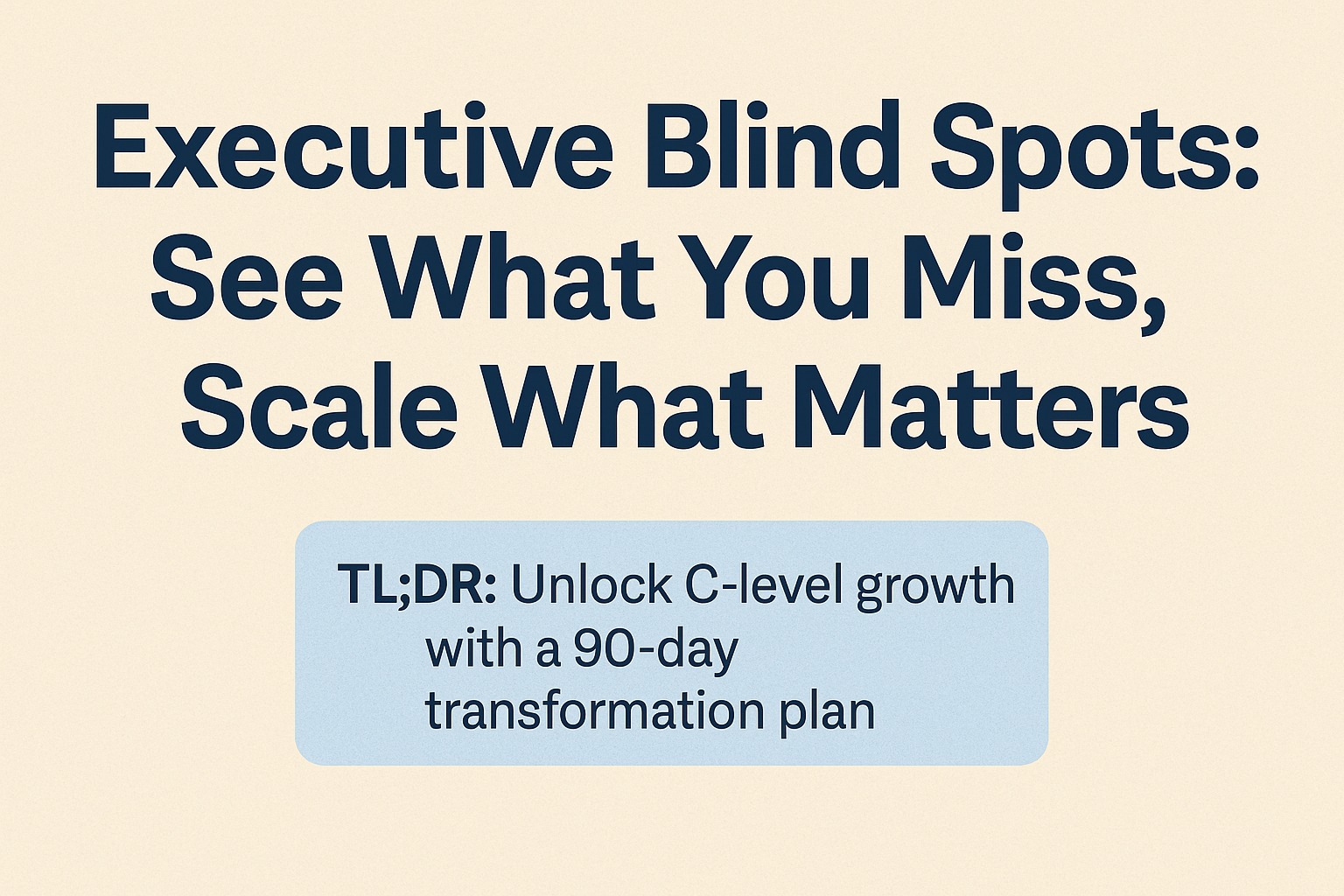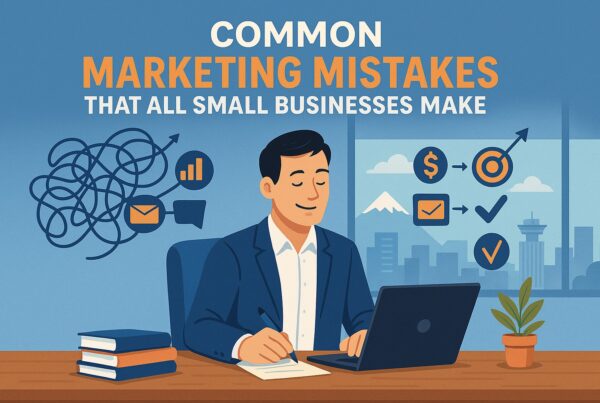Executive Blind Spots: See What You Miss, Scale What Matters
You can’t read the label from inside the jar
TL;DR: Who: CEOs & senior leaders seeking visible, board‑ready results. Outcome: Faster decisions, fewer escalations, stronger cross‑functional performance. Promise: A lightweight 90‑day plan to surface blind spots and lock in a repeatable operating cadence.
If growth has stalled, it’s probably not the market. This guide shows how to surface blind spots and install a 90‑day operating cadence. A blind spot is a repeatable leadership pattern you can’t see that taxes results. When those plateau, the default story is external—market headwinds, talent shortages, distracted customers. Yet in my experience, the quiet tax on performance is internal: blind spots. They’re not flaws; they’re the natural byproduct of success and speed. The higher you climb, the narrower your unfiltered feedback becomes, and the more invisible your own patterns are.
This is where executive coaching pays for itself—by making the unseen, seen—then building the habits, systems, and cadences that keep you from drifting back into old patterns.
The 7 Executive Blind Spots (and How They Show Up)
1) Strategy–Execution Gap
What it looks like: Clear plans without weekly cadence; WIGs exist but drift; owners unclear.
Impact: Initiative fatigue, missed targets, low follow‑through.
Signal to watch: Weekly commitment completion rate; KPI visibility by team.
Fix: Install a weekly operating rhythm (scorecard → commitments → roadblocks) and hold 90%+ commitment completion.
2) Decision Latency
What it looks like: Projects stall waiting for your call; meetings end with “circle back.”
Impact: Slower cycle times, missed windows, team frustration.
Signal to watch: Proposal→decision lead time; % meetings ending with a single owner/decision.
Fix: Set decision SLAs (e.g., 72 hours) and standardize Tier‑1 decision memos with owner/date.
3) Founder/Leader Bottleneck (Heroic Dependence vs. System Reliance)
What it looks like: Everything escalates to you; you’re solver‑of‑last‑resort.
Impact: Your burnout; team learned helplessness.
Signal to watch: % of decisions made one level below; # of documented, owned processes.
Fix: Define decision rights & escalation thresholds; document critical processes; require 80% of <$X decisions below you.
4) Misaligned Incentives & KPIs
What it looks like: Local maxima—sales wins, margins erode; velocity up, quality down.
Impact: Cross‑functional friction and short‑termism.
Signal to watch: Balanced scorecard across growth, margin, quality, retention, team health.
Fix: Build a cross‑functional KPI scorecard and align variable comp to shared outcomes.
5) Confirmation Bias & Echo Chambers
What it looks like: Same voices dominate; dissent is “not a fit.”
Impact: Overconfident bets; under‑tested assumptions.
Signal to watch: Frequency that red teams/pre‑mortems change plans; diversity of inputs.
Fix: Run pre‑mortems and red‑team reviews on material bets; assign a rotating devil’s advocate.
6) Culture Debt & Low Psychological Safety
What it looks like: Issues surface late; risk‑taking is theater.
Impact: Slow learning loops; disengaged top talent.
Signal to watch: eNPS trends; “speak‑up” behavior in retros and 1:1s.
Fix: Adopt meeting hygiene, monthly retros, and a speak‑up ritual; model vulnerability and fast follow‑through.
7) Intuition Without Instrumentation
What it looks like: Big calls from the gut; thin data; no decision journal.
Impact: Unrepeatable wins; unexamined losses.
Signal to watch: % of Tier‑1 decisions journaled with assumptions and review dates.
Fix: Journal all Tier‑1 decisions; review monthly; add dashboards for leading indicators.
Coaching unlock: The aim isn’t to “fix you.” It’s to instrument you—so your strengths compound and your defaults don’t silently tax results.
Simple Tools that Surface Blind Spots Fast
| Tool | Use for | Owner | Cadence | Evidence of success |
|---|---|---|---|---|
| External 360 + targeted interviews | Surface leadership/communication blind spots; produce crisp themes and examples | Coach + HR/People Partner | Weeks 1–2; 60‑day follow‑up | 8–12 stakeholders interviewed; 3–5 themes with specific behaviours; ≥2 themes measurably addressed by day 60 |
| Pre‑mortems & Red Teams | Challenge overconfidence; de‑risk big bets | Initiative sponsor + rotating devil’s advocate | For all material bets; quarterly planning | ≥1 pre‑mortem per material initiative; ≥30% plans adjusted; forecast‑to‑actual variance ↓ |
| Decision Journals | Improve decision quality; reduce drift and re‑litigation | Executive + EA/Chief of Staff | Log in real time; 30‑min monthly review | ≥90% Tier‑1 decisions logged; proposal→decision lead time ↓; ≥1 lesson captured per month |
| Observational Audits (exec meetings) | Fix strategy‑execution gap; enforce meeting hygiene | Coach/Chief of Staff | 2× in first month; then quarterly | Meeting Hygiene Score ≥80%; ≥90% meetings end with single owner/date/metric |
| Weekly Scorecards | Align incentives and focus; drive follow‑through | Function leads + Executive | Weekly | 5–7 KPIs per team visible; 90% commitment completion; cross‑functional metrics balanced across growth/margin/quality/retention |
| Customer Listening Rhythm | Reduce confirmation bias; feed product/ops roadmaps | Executive + Product/CS lead | 4–6 customer calls per month | ≥2 actionable insights/month; NPS ↑; retention ↑; roadmap items explicitly traced to insights |
Templates to embed/link: Decision Journal 1‑pager · Pre‑mortem Prompt · Meeting Hygiene Checklist · Scorecard Template · Stakeholder Interview Guide
- External 360 + targeted interviews: Real talk, anonymized, synthesized into themes and behaviorally specific examples.
- Pre‑mortems & Red Teams: “It’s one year later and we failed—why?” Engineers better plans and raises dissent safely.
- Decision Journals: Capture assumptions, options, and expected results for Tier‑1 calls; review monthly.
- Observational Audits: Sit‑in on exec meetings; measure agenda hygiene, decision clarity, and owner assignment.
- Weekly Scorecards: 5–7 metrics per team; public, owned, and reviewed in a cadence of accountability.
- Customer Listening Rhythm: Monthly call program with open prompts; feed insights to product and ops.
If you want an honest mirror and an actionable playbook, email joel@coachingsuccess.ca with subject “Blind Spot Audit.” I’ll reply with a short intake and two time options for a call.
A 90‑Day Upgrade Plan (Proven, Lightweight, Measurable)

Outcomes at a glance — Baseline → Target (90 days)
| Metric | Baseline | Target (90 days) | Evidence |
| Decision lead time (proposal → decision) | 8–14 days | ≤ 3 days | Decision journal timestamps; meeting notes with owner/date |
| % decisions made one level below you | 40–60% | ≥ 80% | Delegation/decision rights log; escalation data |
| Weekly WIG commitment completion | 50–70% | ≥ 90% | Team scorecards; cadence tracker |
| Meeting Hygiene Score (agenda, owner, metric) | 40–60% | ≥ 80% | Observational audit checklist |
| eNPS (quarterly) | +5 to +20 | +10 pts lift | Anonymous survey; trend chart |
Weeks 1–2: Assess & Align
- Run a focused 360 (8–12 stakeholders). Audit meetings, decisions, and scorecards. Identify 1–2 WIGs and 3–5 lag/lead indicators.
Deliverables: 360 Themes Report (2 pp), Meeting/Decision Audit, Executive KPI Map v1.
Weeks 3–4: Decide & Design
- Choose 2–3 behaviours to change (decision SLAs, delegation rules). Install weekly operating cadence: scorecard → commitments → roadblocks. Map “who decides what” (RACI‑lite) and escalation thresholds.
Deliverables: Operating Rhythm Playbook v1, Decision Rights Charter, EXCO Scorecard v1.
Weeks 5–8: Install & Coach
- Train directs on meeting hygiene and commitment language. Start decision journals for Tier‑1 calls. Red‑team the next strategic bet; open Risk Register.
Deliverables: Tier‑1 Decision Memos (live), Risk Register v1, Strategy‑on‑a‑Page for your WIG.
Weeks 9–12: Inspect & Improve
- Review decisions vs. assumptions; tune metrics; retire vanity KPIs. Lock in rituals that keep drift at bay; publish first trend read‑out.
Deliverables: Decision Quality Review, Scorecard v2 with trends, Board/EXCO Update Narrative.
Ready to install this operating system in the next 90 days? Email joel@coachingsuccess.ca with subject “Blind Spot Audit” and I’ll send a short intake plus two time options.
The 10‑Minute Blind Spot Audit (Score Yourself Now)
Rate each item 0 = never, 1 = sometimes, 2 = consistently.
- Our top 3 goals are written, owned, and visible weekly.
- Every recurring meeting ends with one owner, one date, one metric.
- Tier‑1 decisions are journaled with assumptions and a review date.
- At least one dissenting view is sought before big bets.
- We run monthly customer calls and share raw insights.
- 80% of decisions under $$X are made below me.
- Incentives and KPIs align across growth, margin, quality, and retention.
- Pre‑mortems are used for material initiatives.
- My 1:1s surface obstacles early and end with commitments.
- We publicly celebrate learning from small, fast failures.
Score:
- 0–7: Blind spots likely drive delays and rework—start with Assess & Align.
- 8–14: Foundations in place—tighten cadences and incentives.
- 15–20: Strong operating system—target a specific leadership habit to compound.
Want a second set of eyes on your score? Email joel@coachingsuccess.ca with your total and I’ll send a tailored next step.
Quick Case Snapshot (Anonymized)
A 30‑person services firm stalled at ~$4M ARR. Decisions piled up at the founder; strategy meetings meandered. In 12 weeks we: installed a weekly cadence and scorecards, set decision SLAs, ran a focused 360, and used pre‑mortems on two big bets. Results: proposal‑to‑decision cycle time dropped 42%, gross margin improved 3.1 pts, and employee eNPS rose by 12. Most importantly, the founder got 6 hours/week back to work on strategy.
 FAQ: Coaching for the Blind‑Spot Aware Leader
FAQ: Coaching for the Blind‑Spot Aware Leader
Coach vs. Consultant—what’s the difference here?
Consultants deliver answers. Coaching builds your operating system: clarity, cadence, and behaviors that make great answers likely—consistently.
How fast will I see results?
Usually within 4–6 weeks: cleaner meetings, faster calls, clearer ownership. Structural gains (margin, retention) follow as behaviors stick.
Does this work for small teams?
Yes. In fact, smaller teams can adopt new cadences faster, compounding gains sooner.
What’s the commitment?
We agree on outcomes, metrics, and a weekly rhythm. If we don’t move needles in 90 days, we rethink the plan—together.
Next Step
If you’re ready for an honest mirror and measurable upgrades, let’s talk. Email joel@coachingsuccess.ca with subject “Blind Spot Audit.”




